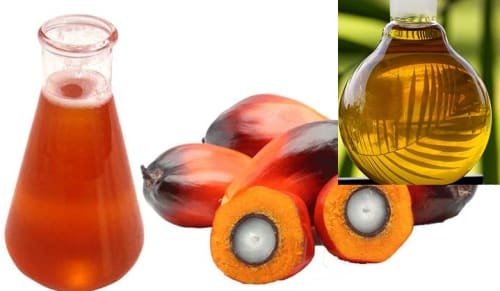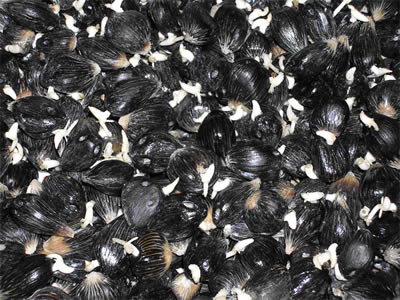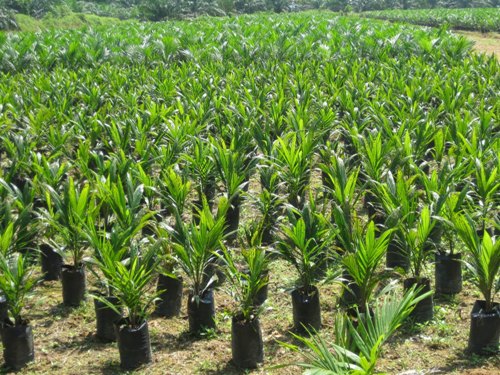Growing Oil Palms (Palm Oil) Guide:
Introduction to Growing Oil Palms:- Oil palm crop is the source of edible vegetable seed oil which is popularly known as ” palm oil”. There is a huge dammed for vegetable seed oils across the world and oil palm is one of them. Oil palms can provide both ‘palm oil’ and ‘kernel oil’. The main advantages of oil palm orchards are excellent yield and wider adaptability of different soils. Palm oil is extracted from the reddish pulp of the fruit of the oil palms, primarily the African oil palms. Because of the high beta-carotene content in Palm oil, it looks reddish in colour. Oil Palms are native to west and southwest Africa and eventually spread across the globe. When it comes to oil palms description, they are single-stemmed and can reach a height over 60 feet. The oil palm leaves are pinnate and can be 10 to 16 ft long. The oil palm flowers are generally produced in dense clusters hand these individual flowers are small and have 3 petals. When it comes to oil palm fruit, these fruits are reddish in colour similar to the size of a large plum, and these fruits grow in large bunches. Each fruit is made up of reddish pulp with a single seed. The oil palm kernel is also used to produce oil.

Advantages of Growing Oil Palms:
- Oil palm is the highest edible oil yielding crop which is about 5 Mt/ ha.
- Small farmers can go for this crop irrigated crop without having any irrigated facilities.
- Oil palm crop is perennial and can yield the crop for 5 to 35 yrs.
- Oil palm is an intensive eco-friendly crop and requires less labor when compared to other oilseed crops.
- Oil palm crop is hardy in nature and has low pest and disease incidence.
- Palm growers can add some extra income by going for Intercropping in the pre-bearing period.
- There is no risk of theft of bunches of the crop.
- This crop provides employment potential to the local population.
- This crop has always assured market price.
- One can obtain assured monthly income throughout the year.
- Oil Palm Produces highly nutritive oil rich in vitamins ‘A’ and ‘E’.
Scientific Name / Botanical Name of Oil Palms:- Elaeis guineensis.
Family Name of Oil Palms:- Arecaceae.
Genus of Oil Palms:- Elaeis.
Palm Oil in Indian Languages:- The following are local names of Oil Palm (Palm oil) in India.
- Palm Oil – English.
- Pana ennai – Tamil.
- పామాయిల్ – Telugu.
- પામ તેલ –
- Pāma tēla – Punjabi.
- ताड़ तेल – Hindi.
- पाम तेल – Marathi.
- পাম তেল /pāma tēla – Bengali.
- ತಾಳೆ ಎಣ್ಣೆ / taale enne – Kannada.
- പന എണ്ണ/ pana eṇṇa – Malayalam.
- Urdu – پام آئل.
World Top 10 Countries of Growing Oil Palms:- Palm oil is being used as cooking oil in the tropical belt of Southeast Asia, Some Parts of Brazil, Africa, and Europe. Palm oil consumption in the commercial food industries is growing day by day due to fewer costs involved in palm oil production and growing. Apart from this, this oil usage in food products has attracted most of the big edible oil manufacturing companies due to numerous health benefits and uses of palm oil. The following are the top 10 producers of oil palms (Palm oil).

- Indonesia.
- Malaysia.
- Thailand.
- Colombia.
- Nigeria.
- Papua New Guinea.
- Ecuador.
- Honduras.
- Cote d’ivoire.
- Brazil.
Health Benefits of Oil Palms:- The following are health benefits and uses of palm oil.

- Palm oil is a good source of Vitamin ‘A’ and ‘E’.
- Palm oil may prevent certain types of cancers.
- Palm oil may prevent brain disease.
- Palm oil works as anti-aging.
- Palm oil is being used to treat malaria.
- Regular consumption of this oil may manage blood pressure.
- Can be used to prevent high cholesterol levels.
- It can also be used for weight loss and to increase the body’s metabolism.
Other Uses:
- As food, palm oil is used in cooking many dishes.
- Industrial use of palm oil ranges from manufacturing cosmetics to making soaps, toothpaste, waxes, and lubricants.
Varieties / Types (Cultivars) of Oil Palms:-
Tenera hybrid variety is mostly grown commercial type with high oil content. Actually, this cultivar is a cross between thick-shelled Dura and shell-less Pisifera.
Climate Requirement for Growing Oil Palms:- Oil palm is a humid crop and requires evenly distributed annual rainfall of 2500 mm to 4000 mm. As we know even rainfall distribution is not possible, it is advised to cultivate oil palm crops under
assured irrigation by adopting recommended practices. Oil palm crop comes up very at mean annual temperature of 20 to 27°C with bright sunlight for at least 5 to 6 hours a day. It is also important to have a humidity of more than 80% for the best yield.
Soil Requirement for Growing Oil Palms:- Oil palm crops can be grown in a wide range of soils. However, this crop thrives best in moist well-drained, deep, permeable, and loamy alluvial soils rich in good humus (organic matter). This crop requires at least a meter depth of soil for easy root penetration in the soil. When growing commercially, a soil test should be carried out to find out the fertility of the soil. However, you should avoid waterlogged, highly alkaline, highly saline and coastal sandy soils.
Propagation in Growing Oil Palms:- Oil Palm crop is propagated through seeds. You can grow the seedlings on nursery beds and can transplant them in the main field. You can directly buy the oil palm seedlings and transport them to the field for transplantation.

For raising seedlings, you should collect fresh, ripe fruits and remove the reddish pulp (mesocarp). For better germination of seeds, maintain temperature about 40°C, ample aeration, and good moisture content(is about 25%). The oil palm seedlings will be ready for transplanting in 12-15 months.
In case if you miss this: Spirulina Farming, Cultivation.

Land Preparation, Season, Planting, and Spacing for Growing Oil Palms:- The best season for planting oil palm is the monsoon. Prepare the land to bring it to the fine tilth stage by giving a couple of deep ploughing. Fields should be prepared at least 3 to 4 months before transplanting the seedlings. You should also make sure the field is good enough to drain the excess water in case of waterlogging by constructing the drainage channels.
Dig the pits of 60 cm x 60 cm x 60 cm prior to planting and fill with surrounding topsoil and allow to settle the soil. Rock phosphate should be applied at 200 to 225 grams pit. Nitrogen and potassium are usually applied 4 – 6 weeks after planting.
The triangular method of planting with 9-meter x 9-meter x 9-meter spacing demands 143 oil palms /ha. For effective utilization of solar light, the planting rows should be oriented in the North-South direction. The equilateral triangular method of planting with 9 meter spacing between oil palm plants will allow each oil palm plant to occupy the center of a hexagon. This allows better use of the area.
Irrigation for Growing Oil Palms:- As the oil palm is a fast-growing crop, it requires a good amount of irrigation. If there is no assured irrigation, do not take up this on a commercial scale. Usually, the trees above 3 years (which start yielding) require 175 to 200 liters per tree per day. In the case of the older plantation, each oil palm demands about 300 liters/day. The method of irrigation can be basin or drip or microjet. In the case of basin irrigation, channels have to be formed by connecting each palm tree. For light soils, frequent irrigation with less water is required wherein in heavy soils, irrigation intervals can be longer due to water holding capacity. The interval of watering in the basin method is about 4 to 5 days.
If drip irrigation is adopted, 4 drippers should be placed for each oil palm. If each dripper discharges 8 liters of water/hour, to cover 160 liters/day/tree, 5-hour irrigation is more than sufficient. Drippers/jets should be periodically checked for the proper discharge of water. Mulch the tree basins to prevent moisture loss and control weeds at the plant basin.
Gap Filling in Growing Oil Palms:- Field inspection is carried out 1 to 2 months after planting to find any pants death. Replanting of these should be done during the onset of the next monsoon. These oil palm plants should be given special care to catch up with the rest of the plantations.
Pollination in Growing Oil Palms:- To ensure the fertilization of all females flowers in the bunch, collect pollen from male inflorescence and dry in Sunlight for about 5 to 6 hours and store in moisture-free containers. This remains viable for over 1 month. You can mix this pollen with chalk powder in the ratio of 1:4 and use it for pollination.
Ablation in Growing Oil Palms:- Ablation is the process of removal of male and female flowers produced in the early stages of oil palm plantation. This process ensures the plants to gain adequate stem girth, vigour, and a strong root system. Carry out ablation immediately after the appearance of inflorescences on the palms.
Flowering in Growing Oil Palms:- Usually, oil palm crops will start flowering within 15 to 18 months after planting. Each palm produces both male and female flowers separately on the same palm.
Intercultural Operations in Growing Oil Palms:- Timely intercultural operation in oil palm growing ensures quality produce and high oil yields.
- Pruning: Pruning should be carried out to remove excess leaves of oil palm trees. Carry out initial pruning just before assisted pollination begins maintaining 2 fronds below the lowest developing bunch. Usually, oil palm trees produce 2 leaves per month. Avoid heavy pruning as it may impact the fruit size and yield. It is advised to carry out the pruning at the end of the monsoon (rainy) season. You can also prune the trees during the low crop season.
- Weed Control: Carry out the regular weeding manually or with the use of only certified and recommended herbicides. Glyphosate 17.5 ml/ each plant basin is recommended for effective weed control at the plant basin. For ground weed control, herbicide mixtures of Paraquat with Atrazine, Monuron, and Diuron should be sprayed on the ground, 2 times a year.
- Mulching: Mulching should be done at oil palm basins in order to prevent any moisture loss and to control weeds. Mulching can also protect from soil erosions in sloppy areas. Mulching materials such as dried leaves, coconut husk can be used.
Inter-cropping in Growing Oil Palms:- Well, Oil palm is a wide-spaced perennial crop having a juvenile period of three years. Commercial palm growers can utilize the inter and intra-row space for growing inter-crops during this 3 years period for generating additional income. Some of the suitable intercrops in growing oil palms are; vegetable crops, banana crops, flower crops, chillies, turmeric, ginger, peanuts, and grain crops.
Manures and Fertilizers for Growing Oil Palms:- Proper manuring and fertilization of oil palm crop is essential as these plants are gross feeders and demand a balanced and ample supply of macro, secondary, and micro-nutrients for growth and quality produce and yield.
Supplement 50 to 60 kg of well decomposed farmyard manure (FMY) like cow dung or green manure before and after planting. The phosphorous should also be applied before planting at the rate of 125 to 150 grams/plant. After 7 years of planting, you should apply N:P:K every year at the rate of 450 grams of ‘N’, 450 grams of ‘P’, and 900 grams of ‘K’ along with 350 grams of Mg per plant.
Pests and Diseases in Growing Oil Palms:- Even though these trees are hardy in nature, the fruits are susceptible to certain pests and diseases.
Some of the common insect pests are bagworms, nettle caterpillars, rhinoceros beetle, bunch moth, termites, and rats. The diseases include Ganoderma basal stem rot and, to a lesser extent, Marasmius bunch rot. Select disease-free seedlings and disease-resistant seeds. Use Integrated Pest Management for controlling these pests and diseases.
Note: Your local department of horticulture is a good source of finding information about pests and diseases in growing oil palms. Don’t experiment on your own without knowing the symptoms and causes.
Harvesting in Growing Oil Palms:- Fruits that are ready to be harvested become loose on the bunch, a sharp knife or chisel attached to a long bamboo stick or pole may be used for oil palm fruit picking. Make sure to leave a stalk length of 5 cm alone while harvesting the fruits. The usual frequency of oil palm harvesting is about 10 to 11 days. In the case of the rainy season, the usual harvesting frequency is about 6 to 7 days as ripening will be quick after the summer season.

Yield in Growing Oil Palms:- Yields of oil palm fruits depend on many factors such as cultivar (variety), irrigation, climate, soil type, tree age, and other orchard management practices. Under optimal growing conditions, one can obtain the following yield.
| Age of oil palm tree (years) | Yield (tonnes) /ha/year |
| 3 to 4 years | 5 |
| 4 to 5 years | 12 |
| 5 to 6 years | 25 |
| 6 to 25 years | 30 |
Marketing in Growing Oil Palms:- You can talk to any oilseed or edible oil processing companies for bulk purchase.
In case if you miss this: Organic Vegetable Farming In Greenhouse.
- Irrigation and Water Management in Pineapple Farming
- Blossom to Harvest: Mastering Flowering and Pollination in Papaya Farming
- Pig Fattening Essentials: From Selection to Sale for Beginners
- Raising Wagyu Cattle: A Complete Guide for Premium Beef Production
- Soil Types and Their Water Holding Capacity
- Optimizing Irrigation Schedules for Coconut Groves for Enhanced Yield
- Espresso Your Garden: Coffee Grounds for Healthier Acid-Loving Plants
- The Best Soil Mix for Snake Plants: How to Mix Your Own Snake Plant Soil
- Green Thumb Success: Expert Tips for Cultivating Greenhouse Beans All Year Round
- Bloom All Year Round: The Ultimate Guide to Indoor Hyacinth Care
- Eco-Friendly Gardening: How to Make Liquid Fertilizer from Kitchen Waste
- Ultimate Guide to Grow Anise in Pots: Explore Seed Propagation to Harvesting
- Guide to Raising Chester White Pigs: Discover Breed Facts to Growth Management
- Mastering the Elegance: The Ultimate Guide to Weeping Cherry Tree Care, Planting, and Maintenance
- Ultimate Guide to Planting Garlic in Grow Bags: Growing Strategies for Beginners
- How to Fix Spider Plant Leaf-Related Problems: Natural and Organic Remedies
- 10 Reasons Why Your Tulsi Plant is Shedding Leaves: Home Remedies and Solutions
- Optimizing Growth and Yield: The Advantages of Palm Bunch Ash Fertilizer

How do we get good yielding palm fruits seedling from you? How much per seedling?
Secondly do you have chick Turkeys for sale